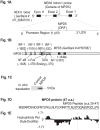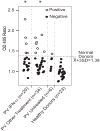A novel unconventional antigen MPD5 elicits anti-tumor humoral immune responses in a subset of patients with polycythemia vera
- PMID: 17624250
- PMCID: PMC2892688
- DOI: 10.1177/039463200702000218
A novel unconventional antigen MPD5 elicits anti-tumor humoral immune responses in a subset of patients with polycythemia vera
Abstract
In an effort to define the antigenic mechanism that contributes to beneficial therapeutic outcome in patients with polycythemia vera (PV), we screened a human testis cDNA library with serological cloning derived from sera of three PV patients who had undergone therapeutic-induced remission. As a result, we identified a novel antigen, MPD5, which belongs to the group of cryptic antigens with unconventional genomic intron/exon structure. Moreover, MPD5 elicited IgG antibody responses in a subset of PV patients who had benefited from a variety of therapies--including IFN-alpha, Hydroxyurea, Imatinib mesylate, Anagrelide, and phlebotomy--but not in untreated PV patients or healthy donors, suggesting that MPD5 is a PV-associated, therapy-related antigen. In the granulocytes of PV patients who are responsive to therapy, upregulated MPD5 expression may serve to enhance immune responses. These findings provide new insight into the mechanism underlying regulation of the self-antigen repertoire that elicits anti-tumor immune responses in patients with myeloproliferative diseases, indicating the potential of these self-antigens as targets of novel immunotherapy.
Figures



Similar articles
-
Novel tumor antigens elicit anti-tumor humoral immune reactions in a subset of patients with polycythemia vera.Clin Immunol. 2007 Mar;122(3):279-87. doi: 10.1016/j.clim.2006.10.006. Epub 2006 Nov 17. Clin Immunol. 2007. PMID: 17113348 Free PMC article.
-
An unconventional antigen translated by a novel internal ribosome entry site elicits antitumor humoral immune reactions.J Immunol. 2006 Oct 1;177(7):4907-16. doi: 10.4049/jimmunol.177.7.4907. J Immunol. 2006. PMID: 16982933 Free PMC article.
-
Diagnosis and treatment of polycythemia vera and possible future study designs of the PVSG.Leuk Lymphoma. 2000 Jan;36(3-4):239-53. doi: 10.3109/10428190009148845. Leuk Lymphoma. 2000. PMID: 10674896 Review.
-
Anagrelide hydrochloride and ruxolitinib for treatment of polycythemia vera.Expert Opin Pharmacother. 2015 Jun;16(8):1185-94. doi: 10.1517/14656566.2015.1036029. Epub 2015 Apr 14. Expert Opin Pharmacother. 2015. PMID: 25873215 Review.
-
Phase II open label trial of imatinib in polycythemia rubra vera.Int J Hematol. 2008 Dec;88(5):489-494. doi: 10.1007/s12185-008-0193-1. Epub 2008 Nov 15. Int J Hematol. 2008. PMID: 19009241 Clinical Trial.
Cited by
-
Canonical Secretomes, Innate Immune Caspase-1-, 4/11-Gasdermin D Non-Canonical Secretomes and Exosomes May Contribute to Maintain Treg-Ness for Treg Immunosuppression, Tissue Repair and Modulate Anti-Tumor Immunity via ROS Pathways.Front Immunol. 2021 May 18;12:678201. doi: 10.3389/fimmu.2021.678201. eCollection 2021. Front Immunol. 2021. PMID: 34084175 Free PMC article.
-
The Role of Immunogenicity in Cardiovascular Disease.World Heart J. 2011 Jan 1;3(1):1-29. World Heart J. 2011. PMID: 24511305 Free PMC article.
-
Cigarette Smoke and Morphine Promote Treg Plasticity to Th17 via Enhancing Trained Immunity.Cells. 2022 Sep 8;11(18):2810. doi: 10.3390/cells11182810. Cells. 2022. PMID: 36139385 Free PMC article.
-
Immune Checkpoints Are New Therapeutic Targets in Regulating Cardio-, and Cerebro-Vascular Diseases and CD4+Foxp3+ Regulatory T Cell Immunosuppression.Int J Drug Discov Pharm. 2024 Dec;3(4):100022. doi: 10.53941/ijddp.2024.100022. Epub 2024 Nov 26. Int J Drug Discov Pharm. 2024. PMID: 39926714 Free PMC article.
References
-
- Lengfelder E, Berger U, Hehlmann R. Interferon alpha in the treatment of polycythemia vera. Ann Hematol. 2000;79:103. - PubMed
-
- Liu E, Jelinek J, Pastore YD, Guan Y, Prchal JF, Prchal JT. Discrimination of polycythemias and thrombocytoses by novel, simple, accurate clonality assays and comparison with PRV-1 expression and BFU-E response to erythropoietin. Blood. 2003;101:3294. - PubMed
-
- Yang XF, Wu CJ, Mclaughlin S, Chillemi A, Wang KS, Canning C, Alyea EP, Kantoff P, Soiffer RJ, Dranoff G, Ritz J. CML66, a broadly immunogenic tumor antigen, elicits a humoral immune response associated with remission of chronic myelogenous leukemia. Proc Natl Acad Sci U S A. 2001;98:7492. - PMC - PubMed
Publication types
MeSH terms
Substances
Grants and funding
LinkOut - more resources
Full Text Sources
Other Literature Sources
Research Materials

